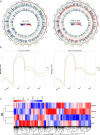DNA methylation mediates differentiation in thermal responses of Pacific oyster (Crassostrea gigas) derived from different tidal levels
- PMID: 32807851
- PMCID: PMC7852555
- DOI: 10.1038/s41437-020-0351-7
DNA methylation mediates differentiation in thermal responses of Pacific oyster (Crassostrea gigas) derived from different tidal levels
Abstract
Epigenetic mechanisms such as DNA methylation have the potential to affect organism acclimatization and adaptation to environmental changes by influencing their phenotypic plasticity; however, little is known about the role of methylation in the adaptive phenotypic divergence of marine invertebrates. Therefore, in this study, a typical intertidal species, the Pacific oyster (Crassostrea gigas), was selected to investigate the epigenetic mechanism of phenotypic plasticity in marine invertebrates. Intertidal and subtidal oysters subjected to one-generation common garden experiments and exhibited phenotypic divergence were used. The methylation landscape of both groups of oysters was investigated under temperate and high temperature. The two tidal oysters exhibited divergent methylation patterns, regardless of the temperature, which was mainly original environment-induced. Intertidal samples exhibited significant hypomethylation and more plasticity of methylation in response to heat shock, while subtidal samples showed hypermethylation and less plasticity. Combined with RNA-seq data, a positive relationship between methylation and expression in gene bodies was detected on a genome-wide scale. In addition, approximately 11% and 7% of differentially expressed genes showed significant methylation variation under high temperatures in intertidal and subtidal samples, respectively. Genes related to apoptosis and organism development may be regulated by methylation in response to high temperature in intertidal oysters, whereas oxidation-reduction and ion homeostasis-related genes were involved in subtidal oysters. The results also suggest that DNA methylation mediates phenotypic divergence in oysters adapting to different environments. This study provides new insight into the epigenetic mechanisms underlying phenotypic plasticity in adaptation to rapid climate change in marine organisms.
Conflict of interest statement
The authors declare that they have no conflict of interest.
Figures






Similar articles
-
Direct and heritable effects of natural tidal environments on DNA methylation in Pacific oysters (Crassostrea gigas).Environ Res. 2021 Jun;197:111058. doi: 10.1016/j.envres.2021.111058. Epub 2021 Mar 20. Environ Res. 2021. PMID: 33757824
-
Transcriptomics and Fitness Data Reveal Adaptive Plasticity of Thermal Tolerance in Oysters Inhabiting Different Tidal Zones.Front Physiol. 2018 Aug 20;9:825. doi: 10.3389/fphys.2018.00825. eCollection 2018. Front Physiol. 2018. PMID: 30210351 Free PMC article.
-
Transgenerational effects of intertidal environment on physiological phenotypes and DNA methylation in Pacific oysters.Sci Total Environ. 2023 May 1;871:162112. doi: 10.1016/j.scitotenv.2023.162112. Epub 2023 Feb 9. Sci Total Environ. 2023. PMID: 36764539
-
Molecular Basis for Adaptation of Oysters to Stressful Marine Intertidal Environments.Annu Rev Anim Biosci. 2016;4:357-81. doi: 10.1146/annurev-animal-022114-110903. Epub 2015 Oct 29. Annu Rev Anim Biosci. 2016. PMID: 26515272 Review.
-
Redox control of antioxidants, metabolism, immunity, and development at the core of stress adaptation of the oyster Crassostrea gigas to the dynamic intertidal environment.Free Radic Biol Med. 2024 Jan;210:85-106. doi: 10.1016/j.freeradbiomed.2023.11.003. Epub 2023 Nov 11. Free Radic Biol Med. 2024. PMID: 37952585 Review.
Cited by
-
High temperature influences DNA methylation and transcriptional profiles in sea urchins (Strongylocentrotus intermedius).BMC Genomics. 2023 Aug 28;24(1):491. doi: 10.1186/s12864-023-09616-7. BMC Genomics. 2023. PMID: 37641027 Free PMC article.
-
Acute heat priming promotes short-term climate resilience of early life stages in a model sea anemone.PeerJ. 2023 Dec 5;11:e16574. doi: 10.7717/peerj.16574. eCollection 2023. PeerJ. 2023. PMID: 38077426 Free PMC article.
-
The effects of temperature and pH on the reproductive ecology of sand dollars and sea urchins: Impacts on sperm swimming and fertilization.PLoS One. 2022 Dec 1;17(12):e0276134. doi: 10.1371/journal.pone.0276134. eCollection 2022. PLoS One. 2022. PMID: 36454769 Free PMC article.
-
Environmental influence on single methylation variation sites (SMVs) in the large yellow croaker (Larimichthys crocea): identification and correlation analysis.Mol Biol Rep. 2024 Dec 31;52(1):93. doi: 10.1007/s11033-024-10154-y. Mol Biol Rep. 2024. PMID: 39738908
-
Plasticity and associated epigenetic mechanisms play a role in thermal evolution during range expansion.Evol Lett. 2023 Jan 31;8(1):76-88. doi: 10.1093/evlett/qrac007. eCollection 2024 Feb. Evol Lett. 2023. PMID: 38370551 Free PMC article.
References
-
- Andrews S. Babraham bioinformatics. Cambridge, United Kingdom: Babraham Institute; 2010.
-
- Aran D, Toperoff G, Rosenberg M, Hellman A. Replication timing-related and gene body-specific methylation of active human genes. Hum Mol Genet. 2011;20(4):670–680. - PubMed
Publication types
MeSH terms
LinkOut - more resources
Full Text Sources

